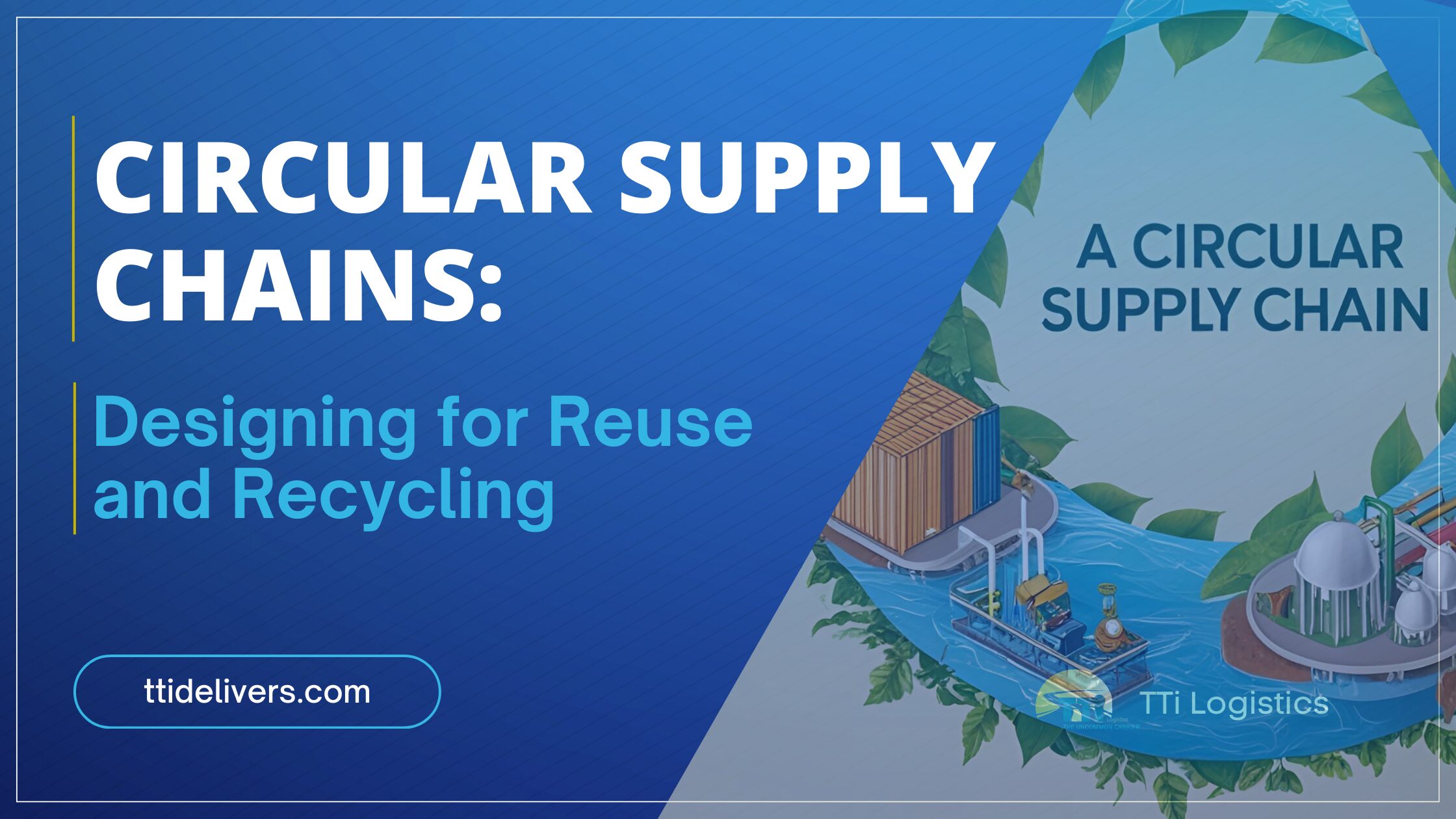The Shift Toward Sustainable Logistics
As the world confronts the environmental impact of traditional manufacturing and waste-heavy logistics, the conversation is shifting toward sustainability. At the heart of this shift is the concept of circular supply chains — a logistics model that minimizes waste, maximizes resource efficiency, and keeps materials in use for as long as possible.
Rather than following a linear path from production to disposal, circular supply chains focus on extending the lifecycle of products through reuse, recycling, refurbishment, and regeneration. As businesses around the world commit to greener practices, TTi Logistics is helping companies align their logistics operations with the principles of circularity.
In this blog, we’ll explore what circular supply chains are, why they’re gaining momentum, and how companies can begin building logistics strategies that prioritize sustainability without sacrificing efficiency.
What Are Circular Supply Chains?
Circular supply chains revolve around three key principles: designing out waste and pollution, keeping products and materials in use, and regenerating natural systems. Unlike traditional linear models that end with product disposal, circular supply chains create value at every stage—through reuse, repair, refurbishment, and recycling. They shift the focus from short-term consumption to long-term resilience and resourcefulness.
Circular supply chains address this by creating processes to reclaim value from end-of-life products and materials. Companies like HP, Nike, and IKEA are already integrating circular models, setting the standard for waste reduction and resource efficiency.
These supply chains require intentional design from the ground up. Businesses must rethink how products are created, distributed, returned, and reintroduced into the cycle. It means moving beyond efficiency to resilience—designing a supply chain that doesn’t just deliver but evolves.
Why Circular Supply Chains Matter
According to the Ellen MacArthur Foundation, adopting circular economy principles could generate $4.5 trillion in economic benefits by 2030. Circular supply chains are a critical component of this transformation.
The business case for circularity is growing stronger. Companies with circular supply chains not only lower their environmental footprint but often outperform peers in innovation and long-term cost management. By transitioning to circular models, companies are future-proofing their operations in a world that increasingly values sustainability.
Components of Circular Supply Chains
Key components include:
- Product Design: Items must be created with longevity, modularity, and disassembly in mind to enable future reuse or recycling.
- Reverse Logistics: Efficient systems must be in place to retrieve products after use and bring them back into the supply chain.
- Material Recovery: Proper sorting, processing, and reintroduction of materials into production help maintain the value of recovered resources.
- Partnerships and Collaboration: A circular model requires manufacturers, retailers, logistics providers, and recyclers to work in sync.
- Digital Tools: Technologies like IoT and blockchain track products through their lifecycle and enable transparency across the chain.
Each element strengthens the foundation of a sustainable, closed-loop logistics system.
Industries Leading the Circular Supply Chain Movement
In electronics, circular strategies include recovering rare earth minerals and refurbishing old devices. In fashion, brands are embracing take-back programs and designing with recycled textiles. Automotive companies are rebuilding engines and remanufacturing parts. Even healthcare providers are extending the lifespan of medical equipment through sterilization and reuse protocols.
These industries are demonstrating how circularity can be both environmentally responsible and economically advantageous.
TTi Logistics: Enabling Circular Supply Chains
TTi Logistics helps companies operationalize circular supply chains by offering:
- Reverse logistics solutions to move returned goods, recyclables, or end-of-life products
- White glove services for sensitive or high-value item recovery
- Asset tracking and reporting tools to monitor product movement and returns
- Flexible warehousing to store, inspect, and sort recovered goods
- Custom packaging and crating to protect refurbished items during transport
Whether you’re collecting used products from consumers, transporting items for refurbishment, or coordinating final-mile delivery of recycled goods, TTi helps ensure your supply chain is aligned with circular economy principles.
Getting Started with Circular Supply Chains
If you’re ready to explore circularity, the best way to begin is by evaluating your current supply chain through a sustainability lens. Here are a few steps to get started:
- Conduct a supply chain audit – Identify where waste is created, what materials are being discarded, and where items could be reused or recycled.
- Engage suppliers and partners – Collaborate with vendors that support sustainable practices and can help you source recyclable or reusable materials.
- Design for disassembly – Work with product designers to create modular, repairable items that can be easily taken apart at the end of their lifecycle.
- Implement reverse logistics – Set up the infrastructure to bring used products back from customers, including collection points, return labels, or pickup options.
- Partner with a logistics expert – Work with providers like TTi Logistics who understand the complexities of circular supply chains and can help you build the systems to support them.
Getting started doesn’t mean overhauling your entire supply chain overnight. It means starting small, measuring impact, and scaling up as you learn.
Challenges and Opportunities
Common obstacles include aligning stakeholders, changing internal processes, and navigating regulatory requirements. Yet, companies that make the shift often uncover hidden efficiencies, strengthen supply chain resilience, and create new revenue streams by giving products a second or third life. Circular supply chains are not just about environmental stewardship—they’re about long-term business success.
Looking Ahead: The Future of Circular Logistics
The rise of conscious consumerism and regulatory pressure means circular supply chains are here to stay. In the future, more companies will treat waste as a resource and logistics as a catalyst for sustainability.
Technologies like AI, IoT, and blockchain will enhance visibility, accountability, and efficiency across circular systems. The supply chain will no longer end at the customer—it will loop back, regenerate, and start again.
Closing the Loop with TTi Logistics
Ready to make your supply chain circular?
TTi Logistics is here to support your journey toward sustainability. Whether you’re launching a new recovery program, need help designing a reverse logistics process, or want expert insight into operational efficiency—we’re your logistics partner for a circular future.
Contact us today to learn how we can help you implement circular supply chain solutions tailored to your business goals.
Circular supply chains represent more than a green trend—they’re a business imperative. With the right logistics partner, companies can close the loop, reduce waste, and unlock new value.
At TTi Logistics, we provide the tools, expertise, and service to help businesses transition from linear to circular models. By rethinking logistics, we’re helping companies rethink what’s possible for the planet, their customers, and their bottom line.
Ready to Rethink Your Supply Chain? ♻️ TTi Logistics makes circular supply chains a reality. Recover, reuse, and recycle with expert support to boost your sustainability efforts. 🌍 Contact us today to get started and turn waste into opportunity! 📦🔄







